When it comes to fishing for snapper there are many problems surrounding the correct way to successfully rig.
Snapper are one of those species that can be difficult at the best of times and having that upper hand can often get you over the line.
With all the myths surrounding the correct tackle and right rigging techniques I have outlined below some of the differences between terminal tackle to help for the next time you hit the water.
Even with today’s technology, some anglers are still hesitant to use braided fishing lines. There are many pros and cons but there are instances when one will out do the other. As a whole, braided lines are superior over monofilament lines in most cases but there are still times when I choose mono.
In my case, when fishing Western Port, offshore or the southern parts of Port Phillip, I use braid for its superior strength, thinner diameter minimising sinker weight and for bite detection capability. I use braid in faster current locations and not in the northern sections of Port Phillip where the current is limited, mainly because braid floats.
I have come to the conclusion that in low current situations where unweighted baits are used it is hard to keep a tight line after casting out and the bait is sinking, as often there will be length of line floating on the surface and not tight to the braid as when using mono.
Should a fish grab the bait, the braid will be pulled into the water before the rod tip loads and with no immediate loading of the rod, the fish may drop the bait before you know about it. When mono is used, due to its thicker diameter it will be tight to the bait while it is sinking and when resting on the bottom. Being tight to the rod, as soon as a fish takes the bait, the rod will load indicating a bite in which the angler can strike to set the hook.
In high tidal flow locations, as mono being the thicker of the two it has more drag on it from water pressure. This can cause more sinker weight to be added often making the situation uncomfortable to fish. Mono, being quite ‘stretchy’ can also mask a bite whereas with braid you can see and feel the tiniest of bites. Mono also has less abrasiveness than braid especially when it comes to line tangles. Should a fish tangle other lines and be heading off at a rate of knots, the braid will always cut any mono line it is tangled with.
For me, as mentioned above, in high tidal locations it is braid all the way and mono for less tidal locations.
Leader lines also have quite a debate about them, so do you choose fluorocarbon or nylon? One thing to note is both nylon and fluoro are made using the same process. The only difference is the polymer used.
Nylon leader line can also be broken into two categories, supple or tough. Supple leaders are quite soft; they have excellent knot strength but less abrasiveness than the tough trace. Tough trace feels a little stiffer and in heavier strengths can be harder to tie good knots.
Nylon leaders are marginally cheaper than fluorocarbon, which often makes them the go-to leader but they are not necessarily better than fluoro. Nylon leaders have far more stretch than fluorocarbon but still retain good knot strength. The unfortunate thing with nylon is that it floats, absorbs water, twists and kinks and is prone to UV exposure that deteriorates the line over a short period of time.
Fluorocarbon on the other hand has far more pros than cons. Fluorocarbon leader is far more expensive, has very little stretch if any, has superior knot strength but each knot must be well lubricated so not to burn or kink the line, has amazing abrasion resistance, sinks and is near invisible under water as it is very close to the light refractive index. This is another plus as it is less affected by UV light and subsequently is prevented from decaying.
Despite its cost, it is a very strong and durable line and for the most part doesn’t absorb water meaning it will retain its strength unlike nylon leaders.
This is a hotly debated topic, mainly because many anglers are set in their own ways and don’t like change. Though I can relate to this as trying to get my father to make the switch is like trying to feed snapper a steak.
Regardless of your forethought there are pros and cons for both but before making the sudden decision, just take a minute to think about the below.
Suicide hooks are your conventional bait fishing hook. There is nothing fancy about them; tie them on, thread on a bait and cast out. When a fish bites at the bait, the most successful technique to secure a fish is to strike to set the hook. The only downfall to this is that you have to be on the ball and strike in that split second.
Is the hand quicker than the eye?
More often it is not and you may pull the bait away from the fish or not strike hard enough and the fish can fall off the hooks during battle. When a suicide hook is used, anglers can let the fish run before striking to ensure a solid hook set but this also can have the fish drop the bait before actually striking.
Circles on the other hand are designed so the fish hook themselves, every time. In saying that, there are times when this won’t happen but this generally occurs when anglers can’t refrane from NOT striking. A circle hook is best used when the rod is left in the rod holder with quite a substantial amount of drag set on the reel.
When the fish takes the bait, it can swallow the entire offering without feeling a prick from the hook, which with suicides can cause the fish to spit out the bait. When the fish turns to completely eat the bait, providing the drag is tight, the hook will pull towards the front of the mouth lodging itself in the jaw scissor. This is a guaranteed hook set and occurs 100% of the time. Should the angler strike, they will lose 100% of their catch, every time.
I am one for using circles and even more so when the fish are finicky. As soon as the bait is swallowed, you can be confident that the fish you have hooked will make it into the boat.
A great debate, who is right and who is wrong? I know may anglers that fish for snapper in different ways and when it comes to the rig, each vow that they are right. At the end of the day, both take home a fair catch of fish so who can decide which the correct way is and which is not.
Depending on where I am fishing I change my rig to suit. In Western Port, I use a single circle hook. Circle hooks always work best by themselves to enable them to be easily swallowed to maximize hook set. In Port Phillip I have used both a running hook and snelled hook setup and found the running suits me best. The differences between the running and snelled mainly differ when it comes to baiting.
Should you use a snelled hook setup, you need to be aware of the distance between the two hooks. If it is not large enough it will be difficult to thread on a whole bait such as a pilchard, silver whiting or garfish. I also find that snelling puts too many twists in the line particularly around the snelled hook which can weaken the line. If the line is going to break, it will most likely break around the snell.
The running hook set up on the other hand is easier to thread whole large baits onto but, can slip when a fish takes the bait This may cause the hooks to bunch together in the mouth of the fish resulting in a larger wear and tear hole that could possibly have the hooks fall out should slack line be given during the fight.
Unfortunately for this debate it is entirely up to the angler to work out what best suits them but for me it is the running hook in Port Phillip and I am yet to have the problem of the hooks bunching up and falling out during battle.
It is all going to come down to time on the water and experimenting to find out what best suits your style of fishing. What I have listed are some of the conundrums I have found over the years and though these may work for me, they may necessarily not work for you. There are no right rules when it comes to fishing, it is all experimenting to find out what works on any given day.
Reads: 14475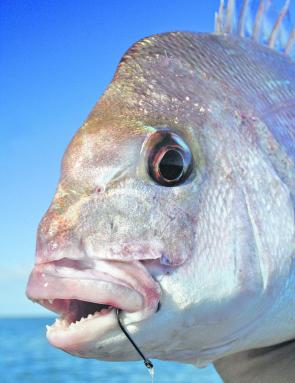
A single circle doing its job nicely.
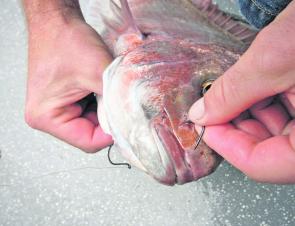
This is one of the problems with the running hook rig. Though the fish maybe hooked, the floating hook often catches somewhere else and cause problems during the battle.
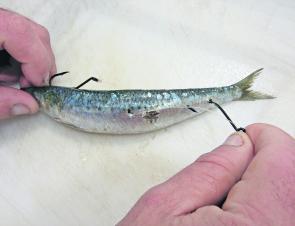
Rigging a pilchard with the running hook rig. To secure the tail hook, two half hitches are required to hold the bait to the hook.
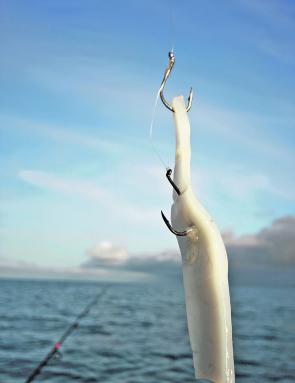
The snelled rig will hold a bait nice and straight in the water.

A whole silver whiting rigged with the running hook rig and ready to be cast.
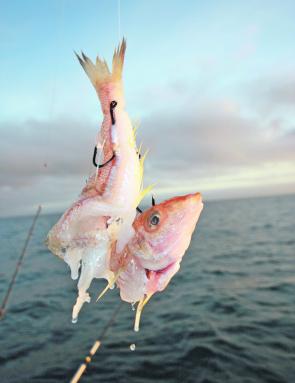
A disadvantage of the running hook rig. The fish has smashed the bait and completely missed the hooks.
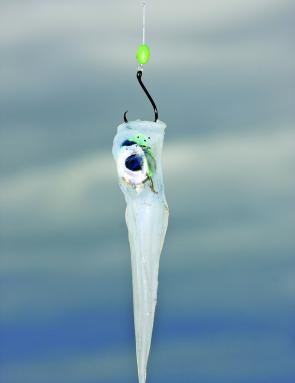
A perfect and well rigged calamari head on a single circle hook.




